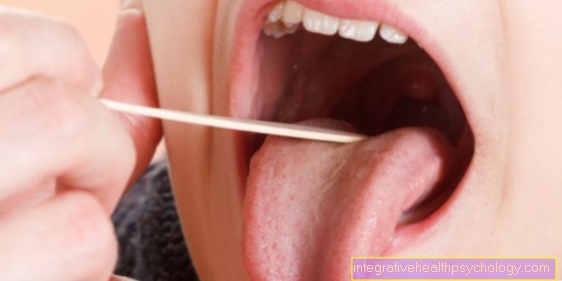Grass mites
General
The grass mite, which is often also referred to as autumn mite, hay mite or autumn grass mite, belongs to the class of arachnids. Their six-legged larvae live parasitically and mainly attack dogs, mice, cats and, in rarer cases, humans.
The human skin disease caused by them is also known as Harvest scabies or Trombidiosis. The grass mite occurs worldwide and shows different distribution patterns depending on the location.
In Europe, grass mites are found mainly in the summer months from July to October. Meadows and gardens are a preferred habitat.

What do grass mite bites look like?
The grass mite bites are usually not noticed directly. They're painless and often won't be noticed until hours later when the immune system reacts to them. This reaction looks a little different for everyone. In some people there are hardly any skin changes to be seen, while others show violent reactions.
Generally, a few hours after the bite is taken, there is little reddening of the bite. They are usually only 1-3 mm in diameter and point-shaped. In some cases, skin changes that are raised above the skin level, known as wheals, form.
They can be up to 1 cm in diameter and itchy. In very sensitive people, the wheals expand to areas where there are no bites. As such, grass mite bites are difficult to distinguish from other insect stings or bites.
Ultimately, you can only assign it to the grass mite if you look at its appearance in combination with how it was formed. If the skin symptoms have been preceded by a long walk in the field or a strenuous day of gardening, grass mites are very likely to be the cause.
The location of the bites is also an indication of the grass mite. The grouped bites are mainly found on warm and moist parts of the body, such as the genital area, the armpits, but also on the legs, arms and shoulders. Furthermore, the areas under tight clothing such as the edges of socks, the waistband or underwear should be checked.
Causes of grass mite bites
Grass mites have shown an increased occurrence in Europe again in recent years.
The exact causes for this are not entirely clear.
Some voices blame climate change for the advance of grass mites. Others, however, claim that the changed recreational behavior of people has become attractive to grass mites.
Increased gardening and long walks in meadows and fields provide food for the larvae. Ultimately, grass mites are increasingly finding favorable habitats such as flat meadows and gardens in our latitudes, which also guarantee food. There they live in colonies on blades of grass and wait for protein-rich food in the form of human lymph fluid. Hosts with a temperature of 30 to 40 ° C are optimal. Thus, humans fall into the prey scheme of the young larvae.
Sandals and shorts are downright inviting for the hungry larvae that get onto the skin from there. They particularly like to settle in warm folds of skin or the edges of socks and suck up lymph and cell juices there.
Diagnosis of harvest dross
The diagnosis of crop scabies - this is the name given to the skin reaction caused by grass mite bites - is relatively easy to make. A few hours after going for a walk or working in the garden, at the latest one day afterwards, itchy, punctiform redness appears.
In contrast to mosquito bites, there are numerous, up to hundreds, bites that are distributed next to each other or in groups. Particularly preferred areas such as the edges of the socks, the genital area, the waistband or the armpits are very suspicious. The grass mite larvae like to stay there due to the warmth and body moisture. In principle, the skin changes could also have other causes, purely based on their appearance, but the temporal connection with gardening or walks in the field - in combination with the symptoms - is the decisive indicator. Further tests, such as laboratory tests, are not necessary.
Read more about this under Itchy skin - these are the causes
Are grass mites contagious?
Grass mites are not contagious to other people. After the larvae have soaked up on humans, they usually fall off the skin again.
Of course, it is possible that the mite larvae remain in the clothing. Renewed bites while wearing the clothes are then possible. Another person who wears this clothing can also be bitten.
Most of the time, however, the larvae are in underwear or socks - these are not necessarily items of clothing that are shared with other people. The larvae are not transmitted through skin contact. The survival of the larvae in their own four walls is also very unlikely, as they find their natural habitat in meadows and gardens.
Incidentally, after eating, mite larvae develop into adult mites. These then no longer feed on humans and do not live as parasites.
Concomitant symptoms
The bites of the grass mite larva trigger different reactions in humans.
Most of the time they are not noticed immediately, as they do not initially hurt or show any other symptoms.
After a few hours, however, a sometimes excruciating itchiness develops in the affected areas and small red spots form that can resemble small pimples. In some people, so-called Wheals, i.e. raised, reddened areas of the skin.
In rare cases, however, the typical itching is absent. This is the case when there is only a weakened response to the bites. For some people this is the case.
In very rare cases, however, pronounced, sometimes allergic, reactions are possible, which lead to severe itching of the entire skin. In addition, wheals can appear all over the body in such cases.
These skin changes result from a reaction of the immune system to the bites of the larvae and not only affect the skin areas where the bites are present. They are very itchy and show up all over your body. Warmth in the bed increases the harmful effect in the first few hours.
After about 14 days, the symptoms subside on their own.
Other accompanying symptoms such as fever, pain or the like are atypical and point to other causes.
Rash in crop scabies
The grass mite bites cause skin changes. For most people, these are limited to the immediate vicinity of the bite.
Here it comes to:
- Redness
- Dot formation
- Wheal formation
These skin changes are usually no larger than 0.1-0.3 cm and last for an average of 2 weeks.
The severity of these skin changes differs from person to person.
Slight discoloration of the skin, which persists even after the symptoms have subsided, is also possible.
In the worst case, scratching the itchy bite marks causes inflammation. These can look different. Often there are reddening, weeping scratch marks. In the event of a bacterial infection of the inflammatory scratch marks, yellow purulent deposits are a possible consequence.
In very rare cases, very pronounced reactions like a rash can be seen. It is then mostly a so-called hives (Urticaria).
A reaction of the immune system to the bites of the larvae causes reddish, raised skin changes that are known as wheals all over the body. They vary in size and in some places flow together to form extensive reddening of the skin.
Wheals are accompanied by itching.
In the case of less pronounced reactions, the punctiform redness, a few millimeters in size, already described, is only present at the bite sites, which are usually present next to each other or in groups.
Please also read: Rash from mites
Treatment / therapy
Bites from the mite larvae do not require medical treatment unless they become infected.
Only symptomatic treatment is possible to alleviate the symptoms.
If the itching is severe, the doctor may prescribe a so-called antihistamine. Light cortisone ointments that are applied to the affected areas also help against the symptoms.
Cooling compresses will also help relieve the itching and swelling.
However, you should avoid home remedies such as lemon juice or vinegar. They can cause further skin irritation and have no proven benefit. It is advisable to shower thoroughly and wash the clothes you are wearing with hot water.
Furthermore, the worn shoes should be washed.
To be on the safe side, the floor should be vacuumed so that fallen larvae can be removed from the apartment or house. Treatment with an antibiotic may be necessary if the bite sites are infected or infected with bacteria. However, this is very rarely the case.
Home remedies
Home remedies should be avoided if grass mite larvae bite.
Although some advisors recommend drizzling lemon juice or vinegar on the larval bites, it is better not to follow these tips.
They can cause further skin irritation and will not help alleviate the discomfort.
Cool compresses and cold yogurt on the skin, on the other hand, help to relieve the swelling and itching. Also avoid the warmth of the bed. This lowers the itching threshold and increases the symptoms.
Grass mites in bed
Fortunately, you don't have to worry about grass mite infestation in your house or apartment.
It is simply not the natural habitat of the mite or even the mite larvae.
Grass mites do not survive in the home bed and, unlike textile mites or bed bugs, do not settle there. If you still want to be on the safe side, after noticing larval bites, vacuum your floor and wash your clothes with hot water.
Then it is practically impossible that larvae are still hiding in the house. So don't be afraid of grass mites in your bed.
However, if bites continue to occur, which are particularly noticeable after bed rest, it is more likely that bed bugs are hiding behind them.
Please also read: Mites in bed - this helps best
Duration
Fortunately, the duration of the discomfort from larval bites is limited to about 10 to 14 days.
The symptoms are most severe in the first three days.
Since the larvae fall off the skin after ingesting food, repeated bites are also unlikely.
In rare cases, however, it is possible that the larvae will bite again after a few weeks or days, causing discomfort. This is the case when worn clothing has not been washed properly and there are still larvae on it.





























